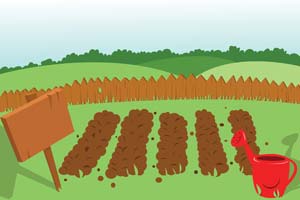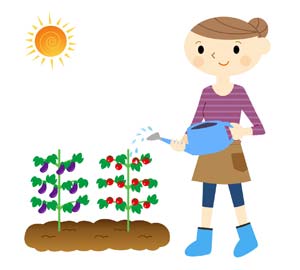 If you’re pushed for time, have rubbish soil or just don’t feel like digging, a no-dig garden could be the solution for you.
If you’re pushed for time, have rubbish soil or just don’t feel like digging, a no-dig garden could be the solution for you.
No matter the state of your soil, a no-dig garden will give you the option to keep planting. Even concrete can accommodate a no-dig patch.
Layers of organic material are laid onto the ground and you plant into that. There’s no digging, no pain, but plenty of gain – and a steady supply of nutrients to your soil as the organic materials slowly break down.
 The idea is simple. Choose a sunny spot and dump a few goodies onto it. If you choose to plant on top of a lawn, mow it first to cut down grass and weeds. On a hard surface such as concrete, add a 10cm layer of branches on the base to allow for drainage. You can add an edging if you wish too, to keep things nice and tidy – a timber frame placed on the ground, or bricks or concrete blocks will suffice – although a frame is not necessary.
The idea is simple. Choose a sunny spot and dump a few goodies onto it. If you choose to plant on top of a lawn, mow it first to cut down grass and weeds. On a hard surface such as concrete, add a 10cm layer of branches on the base to allow for drainage. You can add an edging if you wish too, to keep things nice and tidy – a timber frame placed on the ground, or bricks or concrete blocks will suffice – although a frame is not necessary.
Then lay sheets of damp newspaper about 5mm thick on the ground, overlapping them by 10-15cm. The newspaper will help prevent weeds from emerging.
Next, add lasagne-like layers of carbon and nitrogen. A good carbon source is straw or weed-free hay. Organic material that’s high in nitrogen includes chicken manure, other aged manure, compost mixed with blood and bone, or grass clippings.
Add a layer of straw or hay then water lightly. Then add your nitrogen content.
 Add another layer of carbon and another layer of nitrogen. Add more layers if desired, bearing in mind your no-dig bed will diminish almost half its height in the first six months as it breaks down. If you want a bed that’s 30cm high, for example, build one around 50cm high. Water each layer as you go.
Add another layer of carbon and another layer of nitrogen. Add more layers if desired, bearing in mind your no-dig bed will diminish almost half its height in the first six months as it breaks down. If you want a bed that’s 30cm high, for example, build one around 50cm high. Water each layer as you go.
On your top layer, add some good quality soil to plant your seedlings into. You can cover the entire bed with soil, or just add pockets to plant into, if your beds are large.
Then plant it up! Tomatoes, capsicums, eggplants, beans, broccoli, cabbage, cauliflower, lettuces, silverbeet, spinach and pumpkins all do very well in the no-dig garden.
Keep topping up your garden each year, continuing to layer it with carbon and nitrogenous materials. And just like a normal garden, rotate your crops to minimise plant diseases.
No-dig potato patch
The no-dig concept also works well for spuds. As above, lay sheets of damp newspaper about 5mm thick on the ground. Then add a layer of hay, and then compost. Place your seed potatoes on top and cover with another layer of compost and hay.
As the potato plants grow, continue to add layers of compost and hay, effectively ‘mounding up’ your potatoes, and feed with a fertiliser high in potassium.
 My Favourites
My Favourites










Speak Your Mind